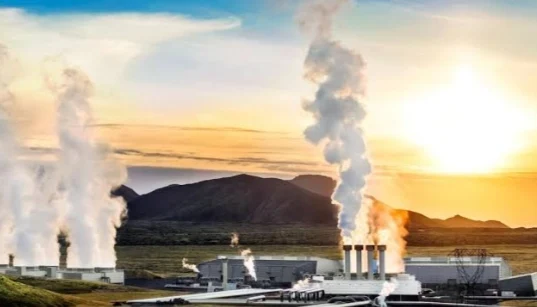Geothermal Energy in South America
North America boasts a much more established geothermal energy landscape compared to South America, with a rich history and diverse range of operational power plant.
In January13, 2024, there are around 100 geothermal power plants scattered across the continent, primarily concentrated in the United States, Mexico, and Canada.
Here's a breakdown of the installed capacity by country:
United States: The clear leader, the US holds the title of global leader in geothermal electricity production, with a whopping 3,676 MW of installed capacity. California, Nevada, Oregon, Idaho, and Utah are home to the majority of these plants, leveraging the abundant geothermal resources found in the "Basin and Range" geologic province.
Mexico: Following closely behind, Mexico possesses around 1,021 MW of installed geothermal capacity. The "Domo San Pedro Geothermal Project" in Nayarit, recently completed in 2023, is a noteworthy example of the country's commitment to expanding its geothermal footprint.
Canada: While still in its early stages of development compared to its neighbors, Canada has around 270 MW of installed geothermal capacity. Provinces like British Columbia and Alberta hold great potential for future geothermal projects.
These figures represent nameplate capacity, which refers to the maximum theoretical output of a power plant. The actual electricity generation can vary depending on factors like operational conditions and geothermal resource characteristics.
Here are some of the largest geothermal power plants in North America:
- The Geysers (California, USA): 1,919 MW
- Coso (California, USA): 280 MW
- Brady-Desert Peak (Nevada, USA): 347 MW
- Dixie Valley (Nevada, USA): 84 MW
- Hell's Kitchen (California, USA): 40 MW (under construction)
The future of geothermal energy in North America looks promising, with ongoing research and development efforts aimed at enhancing the efficiency and cost-effectiveness of this clean and renewable energy source. Additionally, supportive government policies and increasing public awareness about the benefits of geothermal power are contributing to a brighter outlook for this sector.
Table of Geothermal Energy in South America by Country
Geothermal Energy in South America by Country (as of January 13, 2024)
| Country | Installed Capacity (MW) | Operational Plants | Projects in Development | Notes |
|---|---|---|---|---|
| Chile | 81 | ✔️ Cerro Pabellón | El Loa, Coyanco, Puchuldiza | First operational plant in South America |
| Argentina | 0 | ❌ | Copahue (160 MW) | High geothermal potential, regulatory challenges |
| Bolivia | 0 | ❌ | Laguna Colorada (5 MW) | Early exploration stage, low capacity potential |
| Brazil | 0 | ❌ | Brauna, Pipa Nativa | Early exploration stage, limited resources |
| Colombia | 0 | ❌ | Paipa, Cerro Tatara | Exploration and drilling stages, potential for medium-scale projects |
| Ecuador | 0 | ❌ | Chachimbiro (50 MW) | Feasibility studies in progress, potential for small-scale projects |
| Peru | 0 | ❌ | Quellopunco, Chivay | Early exploration stage, potential for geothermal tourism |
Note:
- The table only includes countries with known geothermal projects or potential.
- "Projects in Development" refers to projects in various stages, including exploration, feasibility studies, construction, and permitting.
- The installed capacity for countries with no operational plants is 0 MW.
Frequently Asked Questions about Geothermal Energy in South America
1. What is geothermal energy, and why is it a good option for South America?
- Geothermal energy is heat from the Earth's interior. It's a renewable resource that can be used to generate electricity and heat.
- South America is home to many active volcanoes and tectonic plates, making it an ideal location for geothermal power generation.
2. What are the benefits of geothermal energy in South America?
- Abundant resource: South America has a vast geothermal resource potential.
- Renewable energy: Geothermal energy is a clean and renewable source of power.
- Reliable and stable: Geothermal power plants are less affected by weather conditions than solar or wind power.
- Reduced dependence on fossil fuels: Geothermal energy can help reduce dependence on fossil fuels and lower greenhouse gas emissions.
3. What are the challenges of developing geothermal energy in South America?
- High upfront costs: Developing geothermal power plants can be expensive.
- Environmental concerns: Geothermal power plants can have potential environmental impacts, such as water pollution and induced seismicity.
- Technical challenges: Drilling deep into the Earth to access hot water or steam can be technically challenging.
4. What are some examples of geothermal power projects in South America?
- Chile: Chile is a leader in geothermal energy development, with several geothermal power plants in operation.
- Ecuador: Ecuador has significant geothermal potential and is developing geothermal projects.
- Peru: Peru has several geothermal prospects and is exploring the potential for geothermal power generation.
5. What is the future of geothermal energy in South America?
- The future of geothermal energy in South America looks promising. With increasing demand for renewable energy and advancements in geothermal technology, South America is well-positioned to become a major geothermal power producer.
6. How can geothermal energy contribute to sustainable development in South America?
- Geothermal energy can contribute to sustainable development in South America by providing a reliable and clean source of energy, creating jobs, and reducing dependence on fossil fuels.


